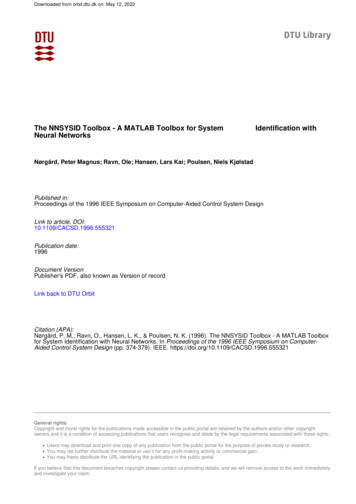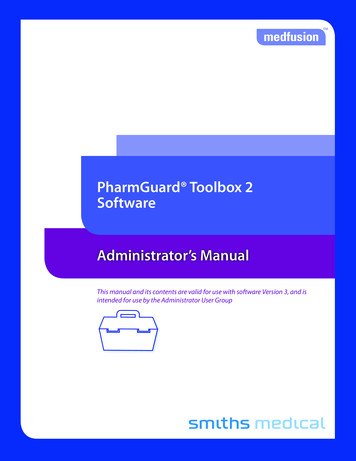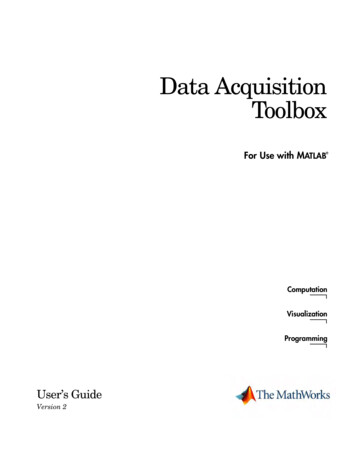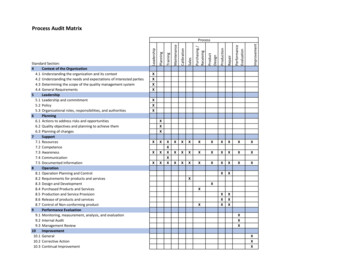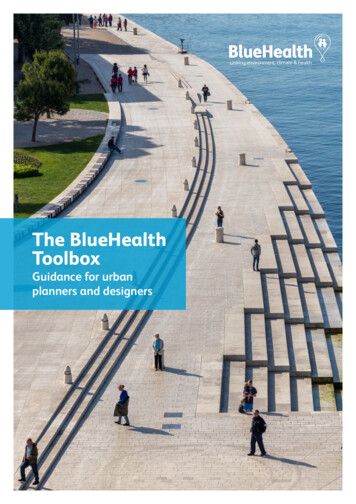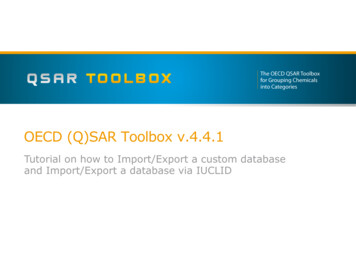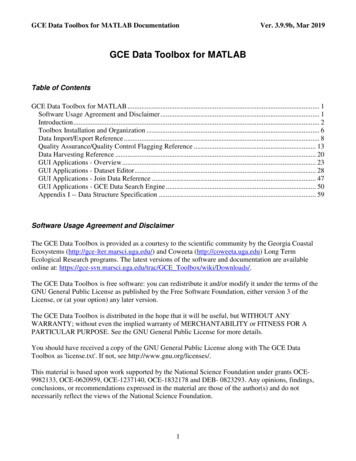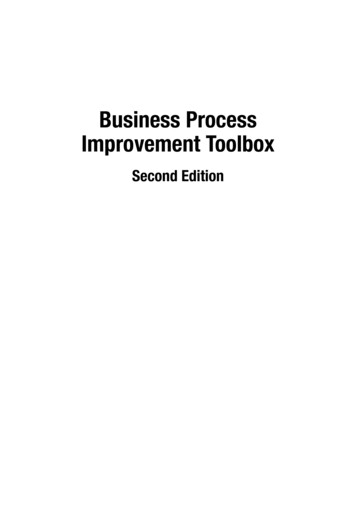
Transcription
Business ProcessImprovement ToolboxSecond Edition
Also available from ASQ Quality Press:Root Cause Analysis: Simplified Tools and Techniques, Second EditionBjørn Andersen and Tom FagerhaugBringing Business Ethics to Life: Achieving Corporate Social ResponsibilityBjørn AndersenPerformance Measurement Explained: Designing and Implementing YourState‑of-the-Art SystemBjørn Andersen and Tom FagerhaugManaging Service Delivery Processes: Linking Strategy to OperationsJean HarveyIntegrating Inspection Management into Your Quality Improvement SystemWilliam D. MawbyEnterprise Process Mapping: Integrating Systems for Compliance andBusiness ExcellenceCharles G. CobbThe Process-Focused Organization: A Transition Strategy for SuccessRobert A. GardnerDecision Process Quality ManagementWilliam D. MawbyThe Process Auditing Techniques GuideJ.P. RussellDefining and Analyzing a Business Process: A Six Sigma Pocket GuideJeffrey N. LowenthalThe Certified Manager of Quality/Organizational Excellence Handbook,Third EditionRussell T. Westcott, editorMaking Change Work: Practical Tools for Overcoming Human Resistanceto ChangeBrien PalmerTo request a complimentary catalog of ASQ Quality Press publications, call800‑248-1946, or visit our Web site at http://www.asq.org/quality-press.
Business ProcessImprovement ToolboxSecond EditionBjørn AndersenASQ Quality PressMilwaukee, Wisconsin
American Society for Quality, Quality Press, Milwaukee 53203 2007 by American Society for QualityAll rights reserved. Published 2007Printed in the United States of America12 11 10 09 08 07 5 4 3 2 1Library of Congress Cataloging-in-Publication DataAndersen, Bjorn.Business process improvement toolbox / Bjorn Andersen.—2nd ed.p. cm.ISBN 978-0-87389-719-8 (alk. paper)1. Reengineering (Management) 2. Benchmarking (Management)3. Reengineering (Management)—Charts, diagrams, etc. I. Title.HD58.87.A53 2007658.4′063—dc222007015967No part of this book may be reproduced in any form or by any means, electronic,mechanical, photocopying, recording, or otherwise, without the prior written permissionof the publisher.Publisher: William A. TonyAcquisitions Editor: Matt MeinholzProject Editor: Paul O’MaraProduction Administrator: Randall BensonASQ Mission: The American Society for Quality advances individual, organizational, andcommunity excellence worldwide through learning, quality improvement, and knowledgeexchange.Attention Bookstores, Wholesalers, Schools, and Corporations: ASQ Quality Pressbooks, videotapes, audiotapes, and software are available at quantity discounts with bulkpurchases for business, educational, or instructional use. For information, please contactASQ Quality Press at 800-248-1946, or write to ASQ Quality Press, P.O. Box 3005,Milwaukee, WI 53201-3005.To place orders or to request a free copy of the ASQ Quality Press Publications Catalog,including ASQ membership information, call 800-248-1946. Visit our Web site atwww.asq.org or http://qualitypress.asq.org.Printed on acid-free paper
ContentsList of Figures . . . . . . . . . . . . . . . . . . . . . . . . . . . . . . . . . . . . . . . . . . . . . . . . .List of Tables . . . . . . . . . . . . . . . . . . . . . . . . . . . . . . . . . . . . . . . . . . . . . . . . . .Preface . . . . . . . . . . . . . . . . . . . . . . . . . . . . . . . . . . . . . . . . . . . . . . . . . . . . . .ixxiiixvChapter 1 Business Process Improvement . . . . . . . . . . . . . . . . . . . . . . . .1.1 Why Is Improvement Necessary? . . . . . . . . . . . . . . . . . . . . . . . . . . .1.2 A Business Process Improvement Framework . . . . . . . . . . . . . . . . .114Chapter 2 Understanding the Organization’s Stakeholdersand Strategic Direction . . . . . . . . . . . . . . . . . . . . . . . . . . . . . .2.1 Stakeholder Expectations of Improvement . . . . . . . . . . . . . . . . . . . .2.2 Reviewing the Organization’s Strategy . . . . . . . . . . . . . . . . . . . . . . .2.3 SWOT Analysis . . . . . . . . . . . . . . . . . . . . . . . . . . . . . . . . . . . . . . . . .2.4 Competitive Forces Analysis . . . . . . . . . . . . . . . . . . . . . . . . . . . . . . .2.5 Strategy Map . . . . . . . . . . . . . . . . . . . . . . . . . . . . . . . . . . . . . . . . . . .9917182022Chapter 3 Understanding Your Current Business Processes . . . . . . . . .3.1 From Processes to Departments to Business Processes . . . . . . . . . .3.2 Definition of a Business Process . . . . . . . . . . . . . . . . . . . . . . . . . . . .3.3 Classification of Business Processes . . . . . . . . . . . . . . . . . . . . . . . . .3.4 Identifying the Organization’s Business Processes . . . . . . . . . . . . . .3.5 Business Process Modeling . . . . . . . . . . . . . . . . . . . . . . . . . . . . . . . .3.6 Relationship Mapping . . . . . . . . . . . . . . . . . . . . . . . . . . . . . . . . . . . .3.7 Traditional Flowchart . . . . . . . . . . . . . . . . . . . . . . . . . . . . . . . . . . . .3.8 Cross- Functional Flowchart . . . . . . . . . . . . . . . . . . . . . . . . . . . . . . .3.9 Flowchart Divided into Process Areas . . . . . . . . . . . . . . . . . . . . . . . .3.10 Several- Leveled Flowchart . . . . . . . . . . . . . . . . . . . . . . . . . . . . . . . .3.11 Flowchart with Statistics . . . . . . . . . . . . . . . . . . . . . . . . . . . . . . . . . .3.12 Paper and Pencil or PC? . . . . . . . . . . . . . . . . . . . . . . . . . . . . . . . . . .27273234373843465154555862
vi ContentsChapter 4 Using Performance Measurement in Business ProcessImprovement . . . . . . . . . . . . . . . . . . . . . . . . . . . . . . . . . . . . . .4.1 The Role of Performance Measurement in Business ProcessImprovement . . . . . . . . . . . . . . . . . . . . . . . . . . . . . . . . . . . . . . . . . . .4.2 Implementing a Performance Measurement System . . . . . . . . . . . . .4.3 Performance Indicators . . . . . . . . . . . . . . . . . . . . . . . . . . . . . . . . . . .4.3.1 Hard versus Soft Indicators . . . . . . . . . . . . . . . . . . . . . . . . . . .4.3.2 Financial versus Nonfinancial Indicators . . . . . . . . . . . . . . . .4.3.3 Leading versus Lagging Indicators . . . . . . . . . . . . . . . . . . . . .Chapter 5 Creating a Business Process Improvement Road Map . . . . .5.1 Improvement Project Planning . . . . . . . . . . . . . . . . . . . . . . . . . . . . .5.2 Trend Analysis . . . . . . . . . . . . . . . . . . . . . . . . . . . . . . . . . . . . . . . . . .5.3 Spider Chart . . . . . . . . . . . . . . . . . . . . . . . . . . . . . . . . . . . . . . . . . . . .5.4 Performance Matrix . . . . . . . . . . . . . . . . . . . . . . . . . . . . . . . . . . . . . .5.5 Criteria Testing . . . . . . . . . . . . . . . . . . . . . . . . . . . . . . . . . . . . . . . . .5.6 Quality Function Deployment . . . . . . . . . . . . . . . . . . . . . . . . . . . . . .6565677070717275757678818385Chapter 6 Organizing for Business Process Improvement . . . . . . . . . .936.1 Business Process Improvement Skills . . . . . . . . . . . . . . . . . . . . . . . . 936.2 Organizational Modes That Support Business Process Improvement 956.3 Quality Circles . . . . . . . . . . . . . . . . . . . . . . . . . . . . . . . . . . . . . . . . . . 1006.4 Cross- Functional Teams . . . . . . . . . . . . . . . . . . . . . . . . . . . . . . . . . . 1026.5 Stimulating an Improvement Culture . . . . . . . . . . . . . . . . . . . . . . . . 103Chapter 7 The Business Process Improvement Toolbox . . . . . . . . . . . . .7.1 The Need for a Toolbox . . . . . . . . . . . . . . . . . . . . . . . . . . . . . . . . . . .7.2 A Business Process Improvement Model . . . . . . . . . . . . . . . . . . . . .7.3 The Tools in the Toolbox . . . . . . . . . . . . . . . . . . . . . . . . . . . . . . . . . .107107108111Chapter 8 Tools for Collecting Data about thePerformance Shortcoming . . . . . . . . . . . . . . . . . . . . . . . . . . .8.1 Sampling . . . . . . . . . . . . . . . . . . . . . . . . . . . . . . . . . . . . . . . . . . . . . .8.2 Surveying . . . . . . . . . . . . . . . . . . . . . . . . . . . . . . . . . . . . . . . . . . . . . .8.3 Check Sheet . . . . . . . . . . . . . . . . . . . . . . . . . . . . . . . . . . . . . . . . . . . .8.4 Problem Concentration Diagram . . . . . . . . . . . . . . . . . . . . . . . . . . . .113113115117119Chapter 9 Tools for Analyzing the Performance Shortcoming . . . . . . .9.1 Critical Incident . . . . . . . . . . . . . . . . . . . . . . . . . . . . . . . . . . . . . . . . .9.2 Pareto Chart . . . . . . . . . . . . . . . . . . . . . . . . . . . . . . . . . . . . . . . . . . . .9.3 Cause- and-Effect Chart . . . . . . . . . . . . . . . . . . . . . . . . . . . . . . . . . . .9.4 Five Whys Analysis . . . . . . . . . . . . . . . . . . . . . . . . . . . . . . . . . . . . . .123123125128132
Contents vii9.59.69.79.89.99.10Scatter Chart . . . . . . . . . . . . . . . . . . . . . . . . . . . . . . . . . . . . . . . . . . .Histogram . . . . . . . . . . . . . . . . . . . . . . . . . . . . . . . . . . . . . . . . . . . . .Relations Diagram . . . . . . . . . . . . . . . . . . . . . . . . . . . . . . . . . . . . . . .Matrix Diagram . . . . . . . . . . . . . . . . . . . . . . . . . . . . . . . . . . . . . . . . .Is–Is Not Analysis . . . . . . . . . . . . . . . . . . . . . . . . . . . . . . . . . . . . . . .Bottleneck Analysis . . . . . . . . . . . . . . . . . . . . . . . . . . . . . . . . . . . . . .134136142145148151Chapter 10 Tools for Generating Ideas and Choosingamong Them . . . . . . . . . . . . . . . . . . . . . . . . . . . . . . . . . . . . . .10.1 Brainstorming . . . . . . . . . . . . . . . . . . . . . . . . . . . . . . . . . . . . . . . . . .10.2 Brainwriting/Crawford Slip Method . . . . . . . . . . . . . . . . . . . . . . . . .10.3 Six Thinking Hats . . . . . . . . . . . . . . . . . . . . . . . . . . . . . . . . . . . . . . .10.4 Nominal Group Technique . . . . . . . . . . . . . . . . . . . . . . . . . . . . . . . .10.5 Paired Comparisons . . . . . . . . . . . . . . . . . . . . . . . . . . . . . . . . . . . . . .157157159161163165Chapter 11 Tools for Creating Improvements . . . . . . . . . . . . . . . . . . . . .11.1 Streamlining . . . . . . . . . . . . . . . . . . . . . . . . . . . . . . . . . . . . . . . . . . .11.1.1 Bureaucracy Elimination . . . . . . . . . . . . . . . . . . . . . . . . . . . .11.1.2 Redundancy Elimination . . . . . . . . . . . . . . . . . . . . . . . . . . . . .11.1.3 Value- Added Analysis . . . . . . . . . . . . . . . . . . . . . . . . . . . . . . .11.1.4 Process Cycle Time Reduction . . . . . . . . . . . . . . . . . . . . . . . .11.2 Idealizing . . . . . . . . . . . . . . . . . . . . . . . . . . . . . . . . . . . . . . . . . . . . . .11.3 QFD . . . . . . . . . . . . . . . . . . . . . . . . . . . . . . . . . . . . . . . . . . . . . . . . . .11.4 Statistical Process Control/Control Chart . . . . . . . . . . . . . . . . . . . . .11.4.1 Definitions of Variation . . . . . . . . . . . . . . . . . . . . . . . . . . . . . .11.4.2 Basic Statistics . . . . . . . . . . . . . . . . . . . . . . . . . . . . . . . . . . . .11.4.3 Types of Control Charts . . . . . . . . . . . . . . . . . . . . . . . . . . . . .11.4.4 Constructing Control Charts . . . . . . . . . . . . . . . . . . . . . . . . . .11.4.5 Interpreting the Control Charts . . . . . . . . . . . . . . . . . . . . . . . .11.4.6 Process Capability . . . . . . . . . . . . . . . . . . . . . . . . . . . . . . . . . .11.5 Six Sigma . . . . . . . . . . . . . . . . . . . . . . . . . . . . . . . . . . . . . . . . . . . . . .11.5.1 The Six Sigma Process . . . . . . . . . . . . . . . . . . . . . . . . . . . . . .11.5.2 Six Sigma in the Organization . . . . . . . . . . . . . . . . . . . . . . . .11.6 Business Process Reengineering . . . . . . . . . . . . . . . . . . . . . . . . . . . .11.6.1 A Process for Conducting BPR . . . . . . . . . . . . . . . . . . . . . . . .11.6.2 Planning . . . . . . . . . . . . . . . . . . . . . . . . . . . . . . . . . . . . . . . . .11.6.3 Reengineering . . . . . . . . . . . . . . . . . . . . . . . . . . . . . . . . . . . . .11.6.4 Transformation . . . . . . . . . . . . . . . . . . . . . . . . . . . . . . . . . . . .11.6.5 Implementation . . . . . . . . . . . . . . . . . . . . . . . . . . . . . . . . . . . .11.7 Benchmarking . . . . . . . . . . . . . . . . . . . . . . . . . . . . . . . . . . . . . . . . . .11.7.1 Definitions of Benchmarking . . . . . . . . . . . . . . . . . . . . . . . . .11.7.2 Conducting a Benchmarking Study . . . . . . . . . . . . . . . . . . . 04206207209210211215216221221227
viii ContentsChapter 12 Tools for Implementing Improvements . . . . . . . . . . . . . . . .12.1 A T Analysis . . . . . . . . . . . . . . . . . . . . . . . . . . . . . . . . . . . . . . . . . . .12.2 Tree Diagram and Process Decision Program Chart . . . . . . . . . . . . .12.3 Force Field Analysis . . . . . . . . . . . . . . . . . . . . . . . . . . . . . . . . . . . . .237239241245Chapter 13 Sample University—Improving Student Satisfaction . . . . .13.1 Description of the Organization . . . . . . . . . . . . . . . . . . . . . . . . . . . .13.2 Development of Performance Priorities . . . . . . . . . . . . . . . . . . . . . .13.3 Understanding the Current Processes andPerformance Shortcoming . . . . . . . . . . . . . . . . . . . . . . . . . . . . . . . . .13.4 Analysis of the Performance Shortcoming . . . . . . . . . . . . . . . . . . . .13.5 Generating Ideas and Improvement Proposals . . . . . . . . . . . . . . . . .13.6 Implementation of Improvements . . . . . . . . . . . . . . . . . . . . . . . . . . .251251252Chapter 14 Green Carpet Seed—Revamping the Business Model . . . .14.1 Description of the Organization . . . . . . . . . . . . . . . . . . . . . . . . . . . .14.2 Development of Performance Priorities . . . . . . . . . . . . . . . . . . . . . .14.3 Understanding the Current Processes andPerformance Shortcoming . . . . . . . . . . . . . . . . . . . . . . . . . . . . . . . . .14.4 Generating Improvement Ideas . . . . . . . . . . . . . . . . . . . . . . . . . . . . .14.5 Developing an Improved Process . . . . . . . . . . . . . . . . . . . . . . . . . . .14.6 Implementation of the New Service . . . . . . . . . . . . . . . . . . . . . . . . .263263264Appendix Template Package . . . . . . . . . . . . . . . . . . . . . . . . . . . . . . . . . . .SWOT Analysis . . . . . . . . . . . . . . . . . . . . . . . . . . . . . . . . . . . . . . . . . . . . .Trend Analysis . . . . . . . . . . . . . . . . . . . . . . . . . . . . . . . . . . . . . . . . . . . . . .Spider Chart . . . . . . . . . . . . . . . . . . . . . . . . . . . . . . . . . . . . . . . . . . . . . . . .Performance Matrix . . . . . . . . . . . . . . . . . . . . . . . . . . . . . . . . . . . . . . . . . .Criteria Testing . . . . . . . . . . . . . . . . . . . . . . . . . . . . . . . . . . . . . . . . . . . . . .Quality Function Deployment (QFD) . . . . . . . . . . . . . . . . . . . . . . . . . . . . .Relationship Mapping . . . . . . . . . . . . . . . . . . . . . . . . . . . . . . . . . . . . . . . . .Cross-Functional Flowchart . . . . . . . . . . . . . . . . . . . . . . . . . . . . . . . . . . . .Check Sheet . . . . . . . . . . . . . . . . . . . . . . . . . . . . . . . . . . . . . . . . . . . . . . . .Pareto Chart . . . . . . . . . . . . . . . . . . . . . . . . . . . . . . . . . . . . . . . . . . . . . . . .Cause-and-Effect Chart . . . . . . . . . . . . . . . . . . . . . . . . . . . . . . . . . . . . . . .Five Whys Analysis . . . . . . . . . . . . . . . . . . . . . . . . . . . . . . . . . . . . . . . . . .Scatter Chart . . . . . . . . . . . . . . . . . . . . . . . . . . . . . . . . . . . . . . . . . . . . . . . .Histogram . . . . . . . . . . . . . . . . . . . . . . . . . . . . . . . . . . . . . . . . . . . . . . . . . .Relations Diagram . . . . . . . . . . . . . . . . . . . . . . . . . . . . . . . . . . . . . . . . . . .Is–Is Not Analysis . . . . . . . . . . . . . . . . . . . . . . . . . . . . . . . . . . . . . . . . . . . .Paired Comparisons . . . . . . . . . . . . . . . . . . . . . . . . . . . . . . . . . . . . . . . . . .Control Chart . . . . . . . . . . . . . . . . . . . . . . . . . . . . . . . . . . . . . . . . . . . . . . .Force Field Analysis . . . . . . . . . . . . . . . . . . . . . . . . . . . . . . . . . . . . . . . . . 84285286286Bibliography . . . . . . . . . . . . . . . . . . . . . . . . . . . . . . . . . . . . . . . . . . . . . . . . .Index . . . . . . . . . . . . . . . . . . . . . . . . . . . . . . . . . . . . . . . . . . . . . . . . . . . . . . . .287291254257258260266268269271
List of FiguresFigure 1.1Figure 1.2Figure 1.3Figure 2.1Figure 2.2Figure 2.3Figure 2.4Figure 2.5Figure 2.6Figure 2.7Figure 2.8Figure 3.1Figure 3.2Figure 3.3Figure 3.4Figure 3.5Figure 3.6Figure 3.7Figure 3.8Figure 3.9Figure 3.10Figure 3.11Figure 3.12 Without maintenance and improvement, theperformance level decreases. . . . . . . . . . . . . . . . . . . . . . . . . . Business process improvement framework. . . . . . . . . . . . . . . The Deming wheel. . . . . . . . . . . . . . . . . . . . . . . . . . . . . . . . . . The stakeholder model. . . . . . . . . . . . . . . . . . . . . . . . . . . . . . . Stakeholder classification matrix. . . . . . . . . . . . . . . . . . . . . . . The Kano model and the three types of stakeholderrequirements. . . . . . . . . . . . . . . . . . . . . . . . . . . . . . . . . . . . . . . Stakeholder strategies. . . . . . . . . . . . . . . . . . . . . . . . . . . . . . .SWOT analysis results. . . . . . . . . . . . . . . . . . . . . . . . . . . . . . . Five competitive forces. . . . . . . . . . . . . . . . . . . . . . . . . . . . . . Generic strategy map. . . . . . . . . . . . . . . . . . . . . . . . . . . . . . . . Strategy map for the shipping company. . . . . . . . . . . . . . . . . . The contradiction between vertical departments andhorizontal processes. . . . . . . . . . . . . . . . . . . . . . . . . . . . . . . . . A simple business process. . . . . . . . . . . . . . . . . . . . . . . . . . . . The same simple business process, now withdepartment boundaries. . . . . . . . . . . . . . . . . . . . . . . . . . . . . . . Primary and support processes. . . . . . . . . . . . . . . . . . . . . . . . . Business processes in ENAPS. . . . . . . . . . . . . . . . . . . . . . . . . Business processes derived from strategy and stakeholders. . . . . . . . . . . . . . . . . . . . . . . . . . . . . . . . . . . . . . . . . . . The hierarchy of process modeling. . . . . . . . . . . . . . . . . . . . . Example of a relationship map. . . . . . . . . . . . . . . . . . . . . . . . The resulting relationship map for the supply process. . . . . . Flowchart for the supply process. . . . . . . . . . . . . . . . . . . . . . . Flowchart for the filing process. . . . . . . . . . . . . . . . . . . . . . . . Standard IDEF0 diagram design. . . . . . . . . . . . . . . . . . . . . . .ix3571212131519202324282930353637414446474950
List of FiguresFigure 3.13Figure 3.14Figure 3.15Figure 3.16Figure 3.17Figure 3.18Figure 3.19Figure 3.20Figure 4.1Figure 4.2Figure 5.1Figure 5.2Figure 5.3Figure 5.4Figure 5.5Figure 5.6Figure 5.7Figure 5.8Figure 5.9Figure 5.10Figure 5.11Figure 5.12Figure 5.13Figure 5.14Figure 5.15Figure 6.1Figure 6.2Figure 6.3Figure 7.1Figure 8.1Figure 8.2Figure 8.3Figure 9.1Figure 9.2Figure 9.3Figure 9.4Figure 9.5Figure 9.6Figure 9.7Figure 9.8 ample IDEF0 diagram. . . . . . . . . . . . . . . . . . . . . . . . . . . . . .S Example of a cross- functional flowchart. . . . . . . . . . . . . . . . .Cross-functional flowchart for the reporting process. . . . . . . Example of a flowchart divided into process areas. . . . . . . . . Level 0 chart for the process. . . . . . . . . . . . . . . . . . . . . . . . . . Level 1 chart for procurement. . . . . . . . . . . . . . . . . . . . . . . . . Level 1 chart for reporting. . . . . . . . . . . . . . . . . . . . . . . . . . . . Flowchart with bank customer movement statistics. . . . . . . . The performance measurement system design process. . . . . . Performance measurement as an early warning system. . . . . Trend analysis for three example measures. . . . . . . . . . . . . . . Results of the trend analysis. . . . . . . . . . . . . . . . . . . . . . . . . . Example of a spider chart. . . . . . . . . . . . . . . . . . . . . . . . . . . . Spider chart for the central performance measures. . . . . . . . . A generic performance matrix. . . . . . . . . . . . . . . . . . . . . . . . . Performance matrix for the six performance measures. . . . . . Matrix for criteria testing. . . . . . . . . . . . . . . . . . . . . . . . . . . . . Criteria testing for a hair salon chain. . . . . . . . . . . . . . . . . . . . The basic structure of QFD. . . . . . . . . . . . . . . . . . . . . . . . . . . A chain of QFD charts. . . . . . . . . . . . . . . . . . . . . . . . . . . . . . . The house of quality. . . . . . . . . . . . . . . . . . . . . . . . . . . . . . . . . Benchmarking of others’ offers. . . . . . . . . . . . . . . . . . . . . . . . Symbols for the relational matrix. . . . . . . . . . . . . . . . . . . . . . Symbols for the roof matrix. . . . . . . . . . . . . . . . . . . . . . . . . . .QFD chart for an internal IT department. . . . . . . . . . . . . . . . . Traditional organization with vertical silos. . . . . . . . . . . . . . . Organizing along business processes with processowners. . . . . . . . . . . . . . . . . . . . . . . . . . . . . . . . . . . . . . . . . . . Organization of quality circles. . . . . . . . . . . . . . . . . . . . . . . . . Stages in business process improvement work. . . . . . . . . . . . Example of a check sheet. . . . . . . . . . . . . . . . . . . . . . . . . . . . . Check sheet for recording the causes of lost bids. . . . . . . . . . Cutout of city map with streetlight problemconcentration. . . . . . . . . . . . . . . . . . . . . . . . . . . . . . . . . . . . . . Critical incidents for the switchboard operators. . . . . . . . . . . A general Pareto chart with a line for cumulativeimportance. . . . . . . . . . . . . . . . . . . . . . . . . . . . . . . . . . . . . . . . Pareto chart for value of lost jobs. . . . . . . . . . . . . . . . . . . . . . The structure for a fishbone chart. . . . . . . . . . . . . . . . . . . . . . Process chart with fishbone charts for each processstep. . . . . . . . . . . . . . . . . . . . . . . . . . . . . . . . . . . . . . . . . . . . . . Fishbone chart for shaft manufacturing. . . . . . . . . . . . . . . . . . List representation of five whys. . . . . . . . . . . . . . . . . . . . . . . . Five whys analysis chart. . . . . . . . . . . . . . . . . . . . . . . . . . . . 19697102109118119121125126127128130131132133
List of FiguresFigure 9.9Figure 9.10Figure 9.11Figure 9.12Figure 9.13Figure 9.14Figure 9.15Figure 9.16Figure 9.17Figure 9.18Figure 9.19Figure 9.20Figure 9.21Figure 9.22Figure 9.23Figure 9.24Figure 9.25Figure 9.26Figure 9.27Figure 9.28Figure 10.1Figure 10.2Figure 10.3Figure 11.1Figure 11.2Figure 11.3Figure 11.4Figure 11.5Figure 11.6Figure 11.7Figure 11.8Figure 11.9Figure 11.10Figure 11.11Figure 11.12Figure 11.13Figure 11.14Figure 11.15Figure 11.16Figure 11.17 catter charts showing different degrees of correlation. . . . . .S Scatter chart to analyze weather and jobs. . . . . . . . . . . . . . . . Check sheet for the example. . . . . . . . . . . . . . . . . . . . . . . . . . Histogram for the example. . . . . . . . . . . . . . . . . . . . . . . . . . . . Centered process with a small variation width. . . . . . . . . . . . Centered process with a large variation width. . . . . . . . . . . . . Process with a small variation width, but not centered. . . . . . Histogram with two peaks. . . . . . . . . . . . . . . . . . . . . . . . . . . . Histogram that is cut off. . . . . . . . . . . . . . . . . . . . . . . . . . . . . . The principles of a qualitative relations diagram. . . . . . . . . . . Qualitative relations diagram for a poorly functioningmeasurement system. . . . . . . . . . . . . . . . . . . . . . . . . . . . . . . . A general quantitative relations diagram. . . . . . . . . . . . . . . . . Quantitative relations diagram for the example. . . . . . . . . . . . Types of matrix diagrams. . . . . . . . . . . . . . . . . . . . . . . . . . . . . Relations symbols. . . . . . . . . . . . . . . . . . . . . . . . . . . . . . . . . . Matrix diagram for the video rental chain. . . . . . . . . . . . . . . . Generic table for is–is not analysis. . . . . . . . . . . . . . . . . . . . . Ski resort is–is not analysis. . . . . . . . . . . . . . . . . . . . . . . . . . . A bottleneck resource limits the flow from theentire process. . . . . . . . . . . . . . . . . . . . . . . . . . . . . . . . . . . . . Emergency ward bottleneck analysis. . . . . . . . . . . . . . . . . . . . Individual ranking card. . . . . . . . . . . . . . . . . . . . . . . . . . . . . . Resulting flip chart list. . . . . . . . . . . . . . . . . . . . . . . . . . . . . . . Paired comparisons matrix for internal communication. . . . . Value- added analysis questions. . . . . . . . . . . . . . . . . . . . . . . . Cost- cycle time chart. . . . . . . . . . . . . . . . . . . . . . . . . . . . . . . . Corresponding chart after completed value- addedanalysis. . . . . . . . . . . . . . . . . . . . . . . . . . . . . . . . . . . . . . . . . . . A flowchart with steps marked according tostreamlining results. . . . . . . . . . . . . . . . . . . . . . . . . . . . . . . . . Cost- cycle time chart for the original process. . . . . . . . . . . . . Cost- cycle time chart for the streamlined process. . . . . . . . . . Analysis of the current and ideal process in idealizing . . . . . . Idealizing in a printing company. . . . . . . . . . . . . . . . . . . . . . . The general house of quality, the chart used by QFD. . . . . . . House of quality for process improvement. . . . . . . . . . . . . . . Normal distribution curve. . . . . . . . . . . . . . . . . . . . . . . . . . . . Types of control charts and when to use them. . . . . . . . . . . . .– Example of an X chart. . . . . . . . . . . . . . . . . . . . . . . . . . . . . . . Example of an R chart. . . . . . . . . . . . . . . . . . . . . . . . . . . . . . . Control chart with one point outside the control limits. . . . . Chart with several points outside the control limits. . . . . . . . . Process with change in level. . . . . . . . . . . . . . . . . . . . . . . . . 81185188191192197198198
xiiList of FiguresFigure 11.18 A series of 12 or 14 points on the same side ofthe center line. . . . . . . . . . . . . . . . . . . . . . . . . . . . . . . . . . . . . .Figure 11.19 Process with trend. . . . . . . . . . . . . . . . . . . . . . . . . . . . . . . . . .Figure 11.20 Process probably involving tampering. . . . . . . . . . . . . . . . . . .Figure 11.21 Chart displaying cycles. . . . . . . . . . . . . . . . . . . . . . . . . . . . . .Figure 11.22 p chart for one day’s production. . . . . . . . . . . . . . . . . . . . . . .Figure 11.23 Control chart divided into operators. . . . . . . . . . . . . . . . . . . .Figure 11.24 The process for conducting a BPR project. . . . . . . . . . . . . . .Figure 11.25 Process design using the clean sheet approach. . . . . . . . . . . .Figure 11.26 The current process for developing a tailor- made system. . .Figure 11.27 The ideal process. . . . . . . . . . . . . . . . . . . . . . . . . . . . . . . . . . .Figure 11.28 Operational definition of benchmarking. . . . . . . . . . . . . . . . .Figure 11.29 Benchmarking out of the box. . . . . . . . . . . . . . . . . . . . . . . . . .Figure 11.30 Three types of benchmarking based on what isbeing compared. . . . . . . . . . . . . . . . . . . . . . . . . . . . . . . . . . . .Figure 11.31 Recommended combinations of types ofbenchmarking. . . . . . . . . . . . . . . . . . . . . . . . . . . . . . . . . . . . . .Figure 11.32 Progress of a typical benchmarking study. . . . . . . . . . . . . . . .Figure 11.33 Models for organizing a benchmarking study. . . . . . . . . . . . .Figure 11.34 The benchmarking process based on thebenchmarking wheel. . . . . . . . . . . . . . . . . . . . . . . . . . . . . . . .Figure 11.35 Ambition pyramid for benchmarking partners. . . . . . . . . . . .Figure 11.36 Three levels of benchmarking information. . . . . . . . . . . . . . .Figure 11.37 Methods and tools for the observation phase. . . . . . . . . . . . . .Figure 12.1 Matrix for assessing implementation order. . . . . . . . . . . . . . .Figure 12.2 Flowchart for the A T analysis. . . . . . . . . . . . . . . . . . . . . . . .Figure 12.3 A principal tree diagram. . . . . . . . . . . . . . . . . . . . . . . . . . . . .Figure 12.4 Tree diagram for introducing a computer system. . . . . . . . . .Figure 12.5 A general PDPC. . . . . . . . . . . . . . . . . . . . . . . . . . . . . . . . . . . .Figure 12.6 PDPC for the library. . . . . . . . . . . . . . . . . . . . . . . . . . . . . . . . .Figure 12.7 Force field diagram. . . . . . . . . . . . . . . . . . . . . . . . . . . . . . . . .Figure 12.8 Force field analysis for a new library computer system . . . . .Figure 13.1 Sp
ASQ Quality Press at 800‑248‑1946, or write to ASQ Quality Press, P.O. Box 3005, Milwaukee, WI 53201‑3005. To place orders or to request a free copy of the ASQ Quality Press Publications Catalog, including ASQ members
